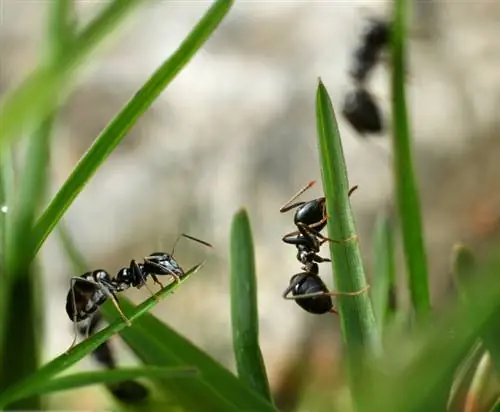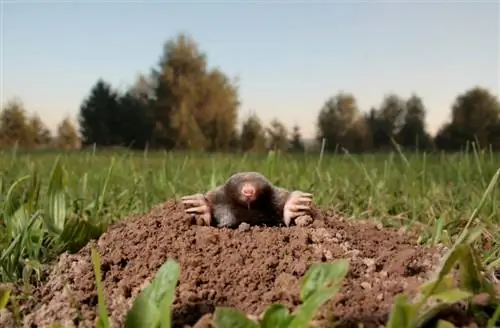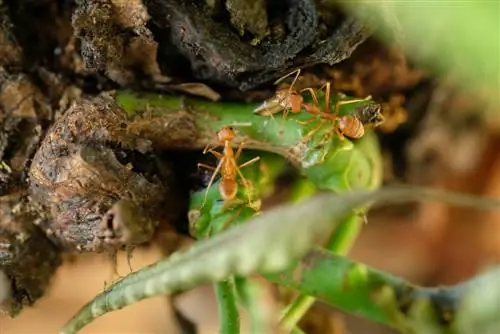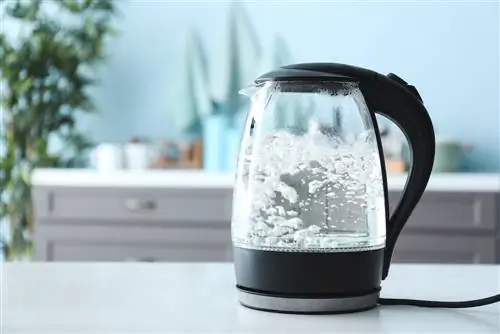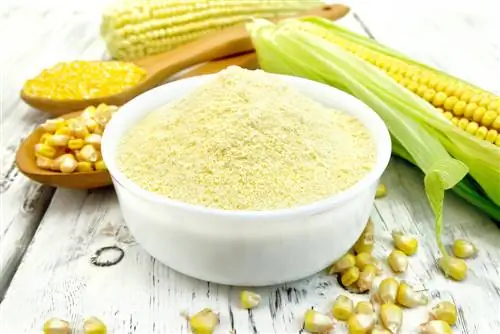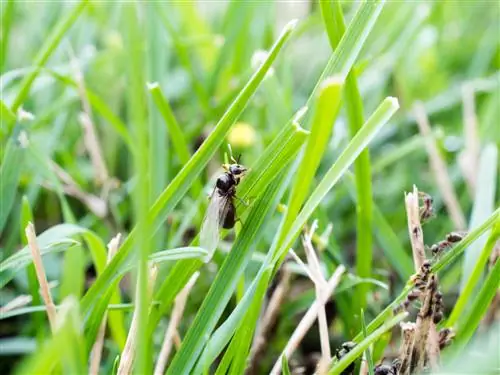- Author admin [email protected].
- Public 2023-12-16 16:46.
- Last modified 2025-06-01 06:02.
If ants boldly nest in the lawn, the siege quickly degenerates into an ant plague. We want to stop the invasion at the latest when ant nests reach the height of molehills. You can read the 10 best tips for poison-free ant control here.
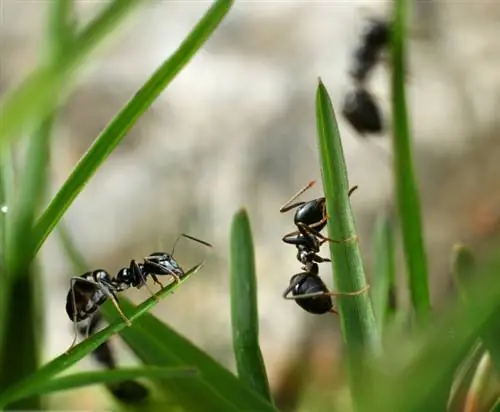
How do I get rid of ants in the lawn in an environmentally friendly way?
To get rid of ants in the lawn effectively and in an environmentally friendly way, you can relocate nests, use smells to scare away, activate natural opponents, use nematodes, disrupt orientation, use baking soda, set up beer traps, disturb nests, use plant manure and fight aphids.
Tip 1: Relocating ant nests - the gentle way
The animal-friendly gardener does not condemn busy ants to death just because they have settled in the lawn. Instead, ant control aims to motivate the insects to move to another shelter. However, this venture is only successful if the queen joins her people. This is how the plan works:
- Fill a large clay pot with wood shavings
- Set this upside down so that it covers the resulting hill
- Alternatively, place it overhead in close proximity to an ant nest
Now give the ants a few days to move. A sure signal of success are long rows of workers carrying the offspring into the pot. As soon as the caravan is over, take a spade, push it under the pot and carry the people to a safe place.
Tip 2: Scare you away with smells - this is how it works
Ants are equipped with a sensitive sense of smell, which is primarily used for orientation. With intense smells, this perception is paralyzed to such an extent that the hymenoptera full of ickies run away. In this way, the ant infestation in the lawn comes to an end quickly without having to bring out the chemical club. These scents promise maximum success:
- Garlic broth
- Mix of camphor and alcohol
- Cheap Perfume
- Japanese medicinal plant oil
If ant nests are repeatedly sprayed with these liquids, the workers pack their bags and the entire colony moves out. A similar effect was achieved by essential herbs that have proven themselves to be effective in natural ant control. If you place eucalyptus, anise, sage, lemon balm, lavender and similar herbs around the ant nests, the ant plague will be history within a short time.
Tip 3: Activate natural opponents
If the ant plague in the lawn gets out of hand, knowledgeable gardeners get help from the pests' predators. The following animals in the garden like to eat ants:
- Birds of all species, especially the green woodpecker
- Beetles, like the black weevil
- Dragonflies
- Spiders
- Toads
One of the most dangerous enemies for ants is the antlion, the insect of the year 2010. The clever antlion catches the creepy crawlies with a self-made funnel trap on fine-grained sand. All of these beneficial insects like to settle in the natural garden. Therefore, create retreats such as a dry stone wall, dense hedges, rotten tree trunks or piles of leaves
Tip 4: End the ant plague with nematodes without poison
Natural opponents of a special kind have been counting ants as part of their prey pattern for millions of years. We're talking about nematodes, tiny roundworms that were discovered in fossil workers. In modern ant control, the nematodes of the Mermis genus are applied as a poison-free preparation to the ant nests, where they eliminate the ant plague.
Tip 5: Disorientate with vinegar and tea tree oil
Functional ant nests rely on the workers always finding their way back there, rich with food for the brood. For this purpose, the insects mark the paths with their body's own scents. The people are doomed if these scents are masked. Vinegar is ideal for this purpose, as is the slightly milder tea tree oil.
If you spray the paths towards the lawn and ant nests with vinegar water or diluted tea tree oil every few days, this measure will end the ant plague in no time. It is important to note that you do not spray the liquid directly onto the grass.
Tip
The yellow meadow ant is one of the most common ant species in Europe. Their ant nests are mainly located in lawns or meadows and are usually completely overgrown. A single colony contains from a few hundred to several thousand workers. There were 100,000 workers in the largest structure discovered so far.
Tip 6: Use baking soda to combat ant infestations
The baking agent baking soda has earned a good reputation in ant control. However, baking soda alone has no effect against the ant plague. Only in combination with sugar can you put an end to the ant plague. When repeatedly scattered on the ant nests, the pests eat the mixture and die from the ammonia released.
Tip 7: Catch ants with beer - this is how it works
Best known as an effective remedy against voracious snails, the beer trap also meets expectations against an ant infestation in the lawn. How to do it right:
- Filling a flat plate with boarded beer
- Mix a tablespoon of honey into it
- Place in the immediate vicinity of the ant nests
Because they are crazy about sweets, the ants crawl into the plate and drown in the alcoholic liquid.
Tip 8: Consistently disturb ant nests as part of lawn care
Considering the swarming around ant nests, it's surprising, but the pests actually want to be left alone. Regular lawn care is therefore an effective way to make things as uncomfortable as possible for the creepy crawlies. This is how you can fight ants by disturbing the peace:
- Mow every 7-10 days from April to September
- Before mowing the lawn, level the mounds of ant nests
- When blowing up the lawn in summer, always include the structure
Annual maintenance liming of the lawn not only prevents the soil from becoming too acidic; At the same time, ants will be careful not to build a new burrow in a whitewashed lawn.
Tip 9: Fighting ants with plant manure - instructions
Lowned up in domestic ant control, you can use the smell of plant manure to effectively combat an ant infestation in the lawn. You can easily make nettle manure yourself and spray it on ant nests until the beasts leave. Using the following recipe, you can not only make nettle manure yourself, but also other mixtures such as wormwood or comfrey broth:
- Soak 1 kilogram of fresh nettle leaves in 10 liters of water
- Set up in a sunny garden spot and cover with wire mesh
- Leave in a wooden vat for 14 days and stir daily
After the fermentation process is complete, the manure is strained and is immediately ready for use. Diluted in a ratio of 1:10, spray the ant nests in the lawn repeatedly. Include the entire lawn and fertilize the green naturally at the same time.
Tip 10: Fighting aphids drives away ants - here's how it works
Where there are aphids on plants, ants are not far away. It is the honeydew that the pests excrete that attracts the ants. Ant control in the garden therefore goes hand in hand with controlling lice. If you are confronted with an ant infestation in your lawn, deprive the insects of their food source by taking the following action against aphids:
- Spray with a mix of 1 liter of water and 15 ml each of curd soap and spirit
- Plants repeatedly pollinated with pure charcoal ash or rock dust
- Cook a broth from 3 cloves of garlic and 1 liter of water and treat the plants
In addition, specialist retailers stock neem or rapeseed oil-based pesticides which have proven to be effective against aphids and therefore also make the garden unattractive for ants.
Tip
The longest life span of a queen ant was 28 3/4 years. The specimen was caught in August 1931 and only died in April 1960. This was a mated black ant queen who laid fertilized eggs until her death.

